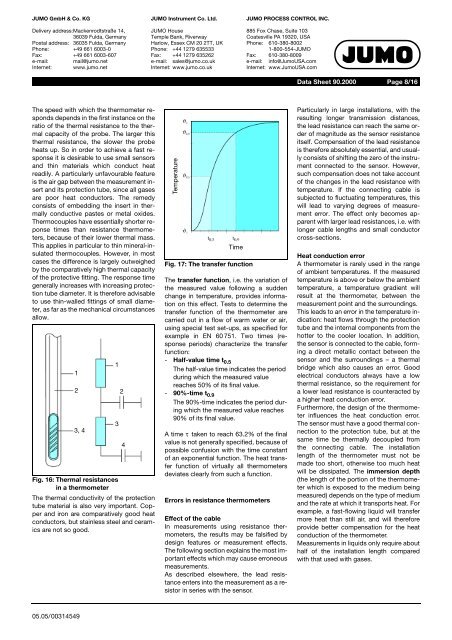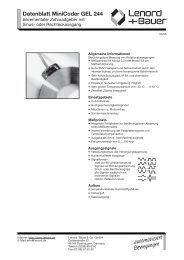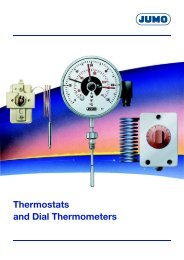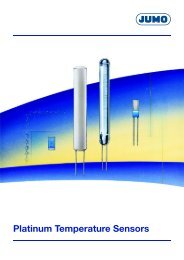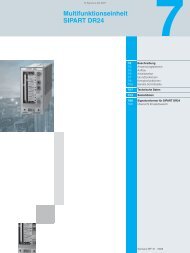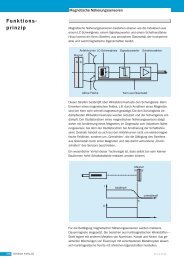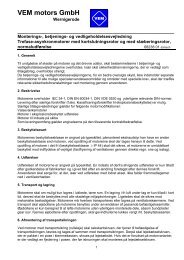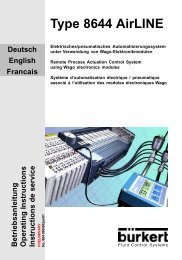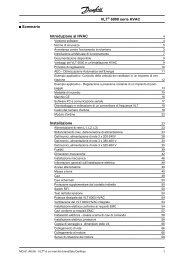Thermocouples - Nuova Elva
Thermocouples - Nuova Elva
Thermocouples - Nuova Elva
Create successful ePaper yourself
Turn your PDF publications into a flip-book with our unique Google optimized e-Paper software.
JUMO GmbH & Co. KG<br />
Delivery address:Mackenrodtstraße 14,<br />
36039 Fulda, Germany<br />
Postal address: 36035 Fulda, Germany<br />
Phone: +49 661 6003-0<br />
Fax: +49 661 6003-607<br />
e-mail: mail@jumo.net<br />
Internet: www.jumo.net<br />
JUMO Instrument Co. Ltd.<br />
JUMO House<br />
Temple Bank, Riverway<br />
Harlow, Essex CM 20 2TT, UK<br />
Phone: +44 1279 635533<br />
Fax: +44 1279 635262<br />
e-mail: sales@jumo.co.uk<br />
Internet: www.jumo.co.uk<br />
JUMO PROCESS CONTROL INC.<br />
885 Fox Chase, Suite 103<br />
Coatesville PA 19320, USA<br />
Phone: 610-380-8002<br />
1-800-554-JUMO<br />
Fax: 610-380-8009<br />
e-mail: info@JumoUSA.com<br />
Internet: www.JumoUSA.com<br />
Data Sheet 90.2000<br />
Page 8/16<br />
The speed with which the thermometer responds<br />
depends in the first instance on the<br />
ratio of the thermal resistance to the thermal<br />
capacity of the probe. The larger this<br />
thermal resistance, the slower the probe<br />
heats up. So in order to achieve a fast response<br />
it is desirable to use small sensors<br />
and thin materials which conduct heat<br />
readily. A particularly unfavourable feature<br />
is the air gap between the measurement insert<br />
and its protection tube, since all gases<br />
are poor heat conductors. The remedy<br />
consists of embedding the insert in thermally<br />
conductive pastes or metal oxides.<br />
<strong>Thermocouples</strong> have essentially shorter reponse<br />
times than resistance thermometers,<br />
because of their lower thermal mass.<br />
This applies in particular to thin mineral-insulated<br />
thermocouples. However, in most<br />
cases the difference is largely outweighed<br />
by the comparatively high thermal capacity<br />
of the protective fitting. The response time<br />
generally increases with increasing protection<br />
tube diameter. It is therefore advisable<br />
to use thin-walled fittings of small diameter,<br />
as far as the mechanical circumstances<br />
allow.<br />
1<br />
2<br />
3, 4<br />
Fig. 16: Thermal resistances<br />
in a thermometer<br />
The thermal conductivity of the protection<br />
tube material is also very important. Copper<br />
and iron are comparatively good heat<br />
conductors, but stainless steel and ceramics<br />
are not so good.<br />
1<br />
3<br />
2<br />
4<br />
Temperature<br />
Time<br />
Fig. 17: The transfer function<br />
The transfer function, i.e. the variation of<br />
the measured value following a sudden<br />
change in temperature, provides information<br />
on this effect. Tests to determine the<br />
transfer function of the thermometer are<br />
carried out in a flow of warm water or air,<br />
using special test set-ups, as specified for<br />
example in EN 60 751. Two times (response<br />
periods) characterize the transfer<br />
function:<br />
- Half-value time t 0.5<br />
The half-value time indicates the period<br />
during which the measured value<br />
reaches 50% of its final value.<br />
- 90%-time t 0.9<br />
The 90%-time indicates the period during<br />
which the measured value reaches<br />
90% of its final value.<br />
A time τ taken to reach 63.2% of the final<br />
value is not generally specified, because of<br />
possible confusion with the time constant<br />
of an exponential function. The heat transfer<br />
function of virtually all thermometers<br />
deviates clearly from such a function.<br />
Errors in resistance thermometers<br />
Effect of the cable<br />
In measurements using resistance thermometers,<br />
the results may be falsified by<br />
design features or measurement effects.<br />
The following section explains the most important<br />
effects which may cause erroneous<br />
measurements.<br />
As described elsewhere, the lead resistance<br />
enters into the measurement as a resistor<br />
in series with the sensor.<br />
Particularly in large installations, with the<br />
resulting longer transmission distances,<br />
the lead resistance can reach the same order<br />
of magnitude as the sensor resistance<br />
itself. Compensation of the lead resistance<br />
is therefore absolutely essential, and usually<br />
consists of shifting the zero of the instrument<br />
connected to the sensor. However,<br />
such compensation does not take account<br />
of the changes in the lead resistance with<br />
temperature. If the connecting cable is<br />
subjected to fluctuating temperatures, this<br />
will lead to varying degrees of measurement<br />
error. The effect only becomes apparent<br />
with larger lead resistances, i.e. with<br />
longer cable lengths and small conductor<br />
cross-sections.<br />
Heat conduction error<br />
A thermometer is rarely used in the range<br />
of ambient temperatures. If the measured<br />
temperature is above or below the ambient<br />
temperature, a temperature gradient will<br />
result at the thermometer, between the<br />
measurement point and the surroundings.<br />
This leads to an error in the temperature indication:<br />
heat flows through the protection<br />
tube and the internal components from the<br />
hotter to the cooler location. In addition,<br />
the sensor is connected to the cable, forming<br />
a direct metallic contact between the<br />
sensor and the surroundings – a thermal<br />
bridge which also causes an error. Good<br />
electrical conductors always have a low<br />
thermal resistance, so the requirement for<br />
a lower lead resistance is counteracted by<br />
a higher heat conduction error.<br />
Furthermore, the design of the thermometer<br />
influences the heat conduction error.<br />
The sensor must have a good thermal connection<br />
to the protection tube, but at the<br />
same time be thermally decoupled from<br />
the connecting cable. The installation<br />
length of the thermometer must not be<br />
made too short, otherwise too much heat<br />
will be dissipated. The immersion depth<br />
(the length of the portion of the thermometer<br />
which is exposed to the medium being<br />
measured) depends on the type of medium<br />
and the rate at which it transports heat. For<br />
example, a fast-flowing liquid will transfer<br />
more heat than still air, and will therefore<br />
provide better compensation for the heat<br />
conduction of the thermometer.<br />
Measurements in liquids only require about<br />
half of the installation length compared<br />
with that used with gases.<br />
05.05/00314549


